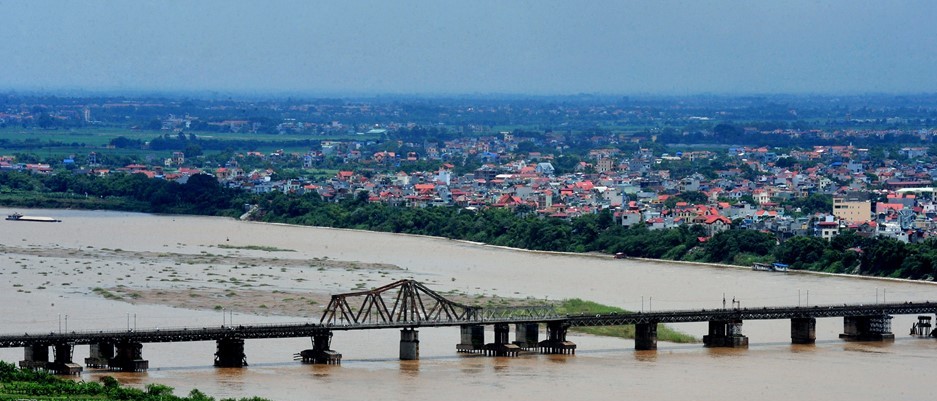A project to build a canal and several hydropower plants on the Red River in Hanoi has been met with concerns due to the risk to local agriculture.

Mega project proposed to be built on Red River
The Ministry of Planning and Investment has sent the Government a trans-Asia waterway and hydropower project planned to be implemented on the Red River at a total cost of VND24.5 trillion (US$1.1 billion).
According to an investment plan for the project of Xuan Thien Co Ltd based in the northern province of Ninh Binh, the project consists of three or six dams to be built on the river and dredging a 288-kilometer river section from Viet Tri City in Phu Tho Province to Lao Cai City in the province of the same name.
The plan will construct seven ports along the waterway, including Pho Moi, Apatite, Quy Xa, Van Phu, Ngoc Thap, Co Tiet, and a port north of Hanoi to meet demand of enterprises for transporting minerals and construction materials in the provinces which the waterway would pass through.
The investor said its own finances would account for 30% of the total investment cost and bank loans for the remainder.
The company proposed implementing the project under the build-own-operate (BOO) format. It wanted to collect fees from VND10,000 to VND45,000 per ton of cargo transported on the waterway and sell electricity at an initial price of VND1,900 per kWh and VND3,560 per kWh later to recover the investment capital over a period of about 25 years.
The company said the project would help create a smooth waterway from Lao Cai to Haiphong City for vessels of 400 to 600 DWT and generate 912 million kWh per year once it is completed.
The project is expected to keep water levels at the dams below annual flooding levels and thus preventing flooding for localities along the waterway.
The investor put the social benefits of the project at VND2.7 trillion (US$121.4 million) per year, including VND600-750 billion saved from cargo transport by road. It would contribute 5% of gross domestic product (GDP) growth in the localities that would benefit directly from the project.
However, the Vietnam Inland Waterway Administration is concerned that the combination of waterway and hydropower dams on the river would obstruct traffic on the river.
In December 2015, the Government assigned the Ministry of Planning and Investment to join hands with the Ministry of Transport and other relevant ministries, agencies and localities to evaluate the project and report results to the Prime Minister. Xuan Thien Co Ltd was asked to prepare relevant documents and procedures for the project.
The Ministry of Transport is implementing a Red Delta transport development (WB6) project covering 14 provinces and cities in the region at a total cost of US$200 million, including US$170 million lent by the World Bank (WB) and US$30 million in reciprocal capital from the Vietnamese Government.
Phase one of the project comprises Waterway Corridor No. 1 connecting Viet Tri and Quang Ninh Province via Duong River with a total investment of about US$60 million. This phase has been put into use, and helped promote waterway transport between Quang Ninh, Haiphong, Hanoi and Viet Tri as it allows vessels, especially container ones, to enter inland ports.
Phase two of the project is to upgrade Waterway Corridor No. 3 connecting Hanoi and Lach Giang in Nam Dinh Province, build embankments, install signal buoys along the route and dredge channels through Lach Giang estuary with a cost totaling US$110 million.
If approved, the trans-Asia waterway project, together with the WB6 project, is expected to form a seamless network of waterways in the northern region, reduce goods transport by road, and help logistics enterprises save shipping costs.
Red River mega project faces strong opposition
Tran Dinh Long, deputy chairman of the Vietnam Power Association, said the Laotian and Chinese hydropower plants upstream of the Mekong River have affected the lives of millions of people in the Mekong Delta so they should not touch the Red River as the power plants will affect the alluvium, water flow and may cause salt water intrusion."The Red River Delta is one of Vietnam's most important rice granaries and the river has thousands of years of cultural value.
I think five to seven hydropower plants that have capacity of just some hundreds of MW each aren’t going to make much of the contribution to our network.
Can these plants appease our thirst for energy while we still can exploit solar and wind power?" he said.
He went on to say that the estimated cost was VND24.5bn (USD1bn) but the investors could only cover 30 percent of the cost and had to borrow the rest.
This could lead to bad results with ship owners are forced to pay high fees at ports, especially when this is a build, own and operate project, the investors can use the projects on the Red River indefinitely.
"A BOO project is too dangerous and not appropriate because this project will have a huge impact on our future," he said.
Nguy Thi Khanh, director of GreenID, the green development centre, added that the project would destroy the sediment that has formed over thousands of years.
Tran Viet Ngai, chairman of Vietnam Power Association, said there were many questions need to be answered before carrying out the project.
"Is it really urgent? What'll happen if we don't build the plants there? Is this project meant to develop a canal or hydropower plants?" he said.
SGT/Dtinews